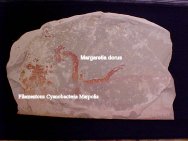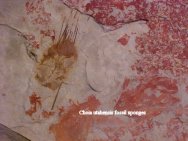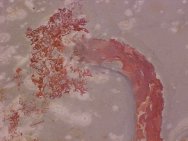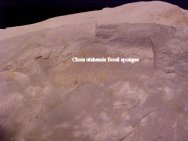Name: Margaretia dorus fossil algae; Marpolia Cyanobacteria, Choia utahensis fossil sponge
Geologic Time: Middle Cambrian
Size: 110 mm and 120 mm Margaretia on 125 mm X 350 mm matrix
Fossil Site: Wheeler Shale, Millard County, Utah
|
Margaretia was a thin, frond-like green algae similar to modern kelp. Although Briggs book (see reference below) shows up to three fronds growing from the base, in Utah I've only seen single and double fronds attached to the base. A few scientists believe Margaretia were a type of sponge or alcyonarian coral. Margaretia are one of the more common megascopic algae in the Wheeler and Marjum Formations, but they are usually poorly preserved and rarely have the contrast of this specimen. Also see: Utah Cambrian Explosion Fossils |



